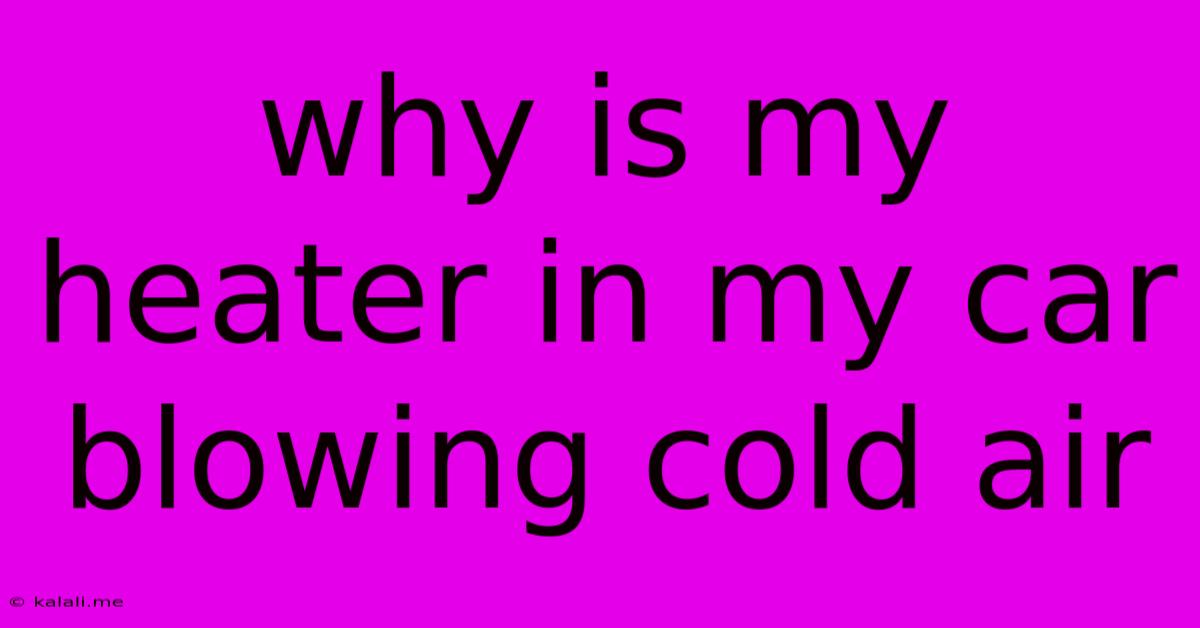Why Is My Heater In My Car Blowing Cold Air
Kalali
May 20, 2025 · 3 min read

Table of Contents
Why Is My Car Heater Blowing Cold Air? A Comprehensive Troubleshooting Guide
Is your car heater refusing to cooperate, leaving you shivering on cold mornings? A car heater blowing cold air is a frustrating problem, but thankfully, it's usually fixable. This comprehensive guide explores the common causes and helps you diagnose the issue, potentially saving you a costly trip to the mechanic. Understanding the system will empower you to tackle this problem effectively.
Common Causes of a Car Heater Blowing Cold Air
Several factors can contribute to a malfunctioning car heater. Let's delve into the most frequent culprits:
1. Low Coolant Levels: The Foundation of Heat
Your car's heater relies on engine coolant to generate warmth. Insufficient coolant means less heat transfer to the heater core, resulting in cold air.
- Check your coolant reservoir: Locate the translucent coolant reservoir (often a plastic tank) and inspect the coolant level. It should be within the minimum and maximum markings. If it's low, add coolant appropriate for your vehicle (check your owner's manual). Low coolant can indicate a leak, requiring immediate attention.
- Look for leaks: Carefully inspect coolant hoses, the radiator, and the engine block for any signs of leaks (wet spots, white residue). Addressing leaks is crucial to prevent overheating and further damage.
2. Faulty Thermostat: The Temperature Regulator
The thermostat is a crucial component that regulates coolant flow. A malfunctioning thermostat can prevent coolant from circulating properly through the heater core.
- Stuck Closed Thermostat: If the thermostat is stuck closed, coolant won't reach the heater core, resulting in cold air. A mechanic may need to replace the thermostat.
- Stuck Open Thermostat: While less common, a stuck-open thermostat can lead to poor heating performance as the engine struggles to reach optimal temperature.
3. Problems with the Heater Core: The Heart of the Heating System
The heater core is a small radiator located inside the dashboard. It heats the air that's blown into the cabin. Several issues can affect its function:
- Clogged Heater Core: Over time, debris and rust can clog the heater core, restricting coolant flow and reducing heating efficiency. This often requires a professional flush or replacement.
- Leaking Heater Core: A leak in the heater core can lead to a loss of coolant and a diminished heating capacity. Repair or replacement may be necessary. This often manifests as a sweet smell inside the car.
- Air Bubbles in the Cooling System: Air pockets can obstruct coolant flow. Bleeding the cooling system (removing trapped air) may restore proper heating. This is often a DIY task but might require specialized tools.
4. Blower Motor Issues: Air Circulation Problems
The blower motor is responsible for pushing air through the heater core and into the cabin. A malfunctioning blower motor can disrupt the heating process:
- Faulty Blower Motor: The motor itself might be failing, causing weak or no airflow. Replacement is often necessary.
- Blower Motor Resistor: This component controls the fan speeds. A failed resistor can restrict airflow or limit fan speed options.
5. Blend Door Issues: Directing the Airflow
Blend doors control the mix of hot and cold air. A malfunctioning blend door can prevent hot air from reaching the vents, even if the heater core is working fine.
- Broken Blend Door Actuator: This small motor controls the blend door. A malfunctioning actuator can cause the blend door to stick in the wrong position.
Troubleshooting Steps:
- Check coolant levels and for leaks.
- Inspect the thermostat (requires some mechanical knowledge).
- Check the blower motor and fan speeds.
- Listen for unusual noises from the dashboard (possible heater core issues).
- Consult your owner's manual for specific instructions and diagrams.
When to Call a Mechanic:
If you're uncomfortable performing any mechanical work or if the problem persists after basic checks, it's best to consult a qualified mechanic. They have the tools and expertise to diagnose and repair more complex issues, ensuring your car's heating system is restored safely and effectively. Remember, a properly functioning heater is crucial for your comfort and safety, especially during colder months.
Latest Posts
Latest Posts
-
Whole Wheat Vs Whole Grain Flour
May 20, 2025
-
What Mob Gives The Most Xp
May 20, 2025
-
How To Cut Nails In Islam
May 20, 2025
-
What To Say Before Someones Surgery
May 20, 2025
-
Can A Citizen Arrest A Police Officer Uk
May 20, 2025
Related Post
Thank you for visiting our website which covers about Why Is My Heater In My Car Blowing Cold Air . We hope the information provided has been useful to you. Feel free to contact us if you have any questions or need further assistance. See you next time and don't miss to bookmark.